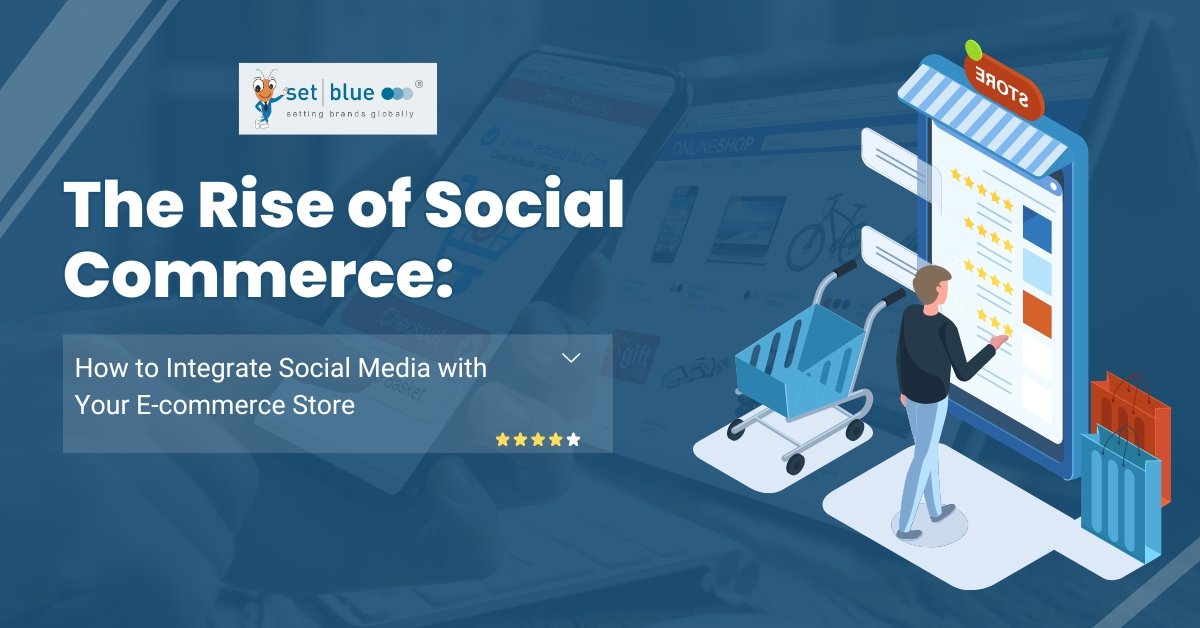The Rise of Social Commerce: How to Integrate Social Media with Your E-commerce Store
The landscape of e-commerce is constantly evolving. While traditional online stores have served us well, a new trend is taking the digital world by storm: social commerce. This powerful approach leverages the immense reach and engagement of social media platforms like Instagram, Facebook, and Pinterest to seamlessly blend product discovery, interaction, and purchase within the social media experience.
For e-commerce businesses in India, social commerce presents a golden opportunity to tap into a massive and highly engaged audience. Let’s delve deeper into this exciting trend and explore how you can integrate social media with your e-commerce store to drive sales and build stronger customer relationships.

Why Social Commerce is Revolutionizing E-commerce
Imagine scrolling through your Instagram feed, stopping in awe at a pair of handcrafted earrings. With a simple tap, you can learn more about the product, read reviews from other customers, and even make the purchase – all without leaving the app. This is the magic of social commerce.
Here’s what makes social commerce so impactful:
- Increased Visibility and Reach: Social media platforms boast billions of active users, providing immense potential for e-commerce businesses to reach new audiences who might not have discovered them otherwise.
- Enhanced Customer Engagement: Social media fosters a more interactive shopping experience. Customers can ask questions, share their experiences, and engage with brands directly, leading to a stronger brand connection.
- Streamlined Shopping Journey: Social commerce removes friction from the buying process. Users can discover products, learn about them, and purchase them directly within the social media platform, eliminating the need to navigate to a separate website.
- Power of User-Generated Content: Social media thrives on user-generated content (UGC) – photos, videos, and reviews shared by real customers. UGC builds trust and social proof, influencing buying decisions and driving sales.
Leveraging Social Media Giants: Instagram, Facebook, and Pinterest
Now, let’s explore how you can leverage the unique strengths of three major social media platforms to integrate social commerce into your e-commerce strategy:
1. Instagram Shopping
Instagram, a visually-driven platform, is a natural fit for showcasing e-commerce products. With features like Shoppable Posts and Stories, you can:
- Create visually appealing product posts: High-quality photos and videos showcasing your products in action are key to grabbing attention on Instagram.
- Tag products in your posts: Use product tags to make your products instantly shoppable. When users tap on a tagged product, they’ll see detailed information and be directed to the product page on your website to complete the purchase.
- Run targeted Instagram Ads: Utilize Instagram’s powerful ad targeting options to reach users most likely to be interested in your products.
- Leverage Instagram Stories and Reels: Showcase new products, behind-the-scenes glimpses, and user-generated content through engaging Stories and Reels.
Example: An Indian clothing brand, “Desi Weaves,” uses Instagram Shopping to showcase their handcrafted kurtas. Stunning visuals, product tags, and engaging Stories featuring customer testimonials have helped them build a loyal following and drive sales directly through Instagram.
2. Facebook Shops and Marketplace
Facebook, with its vast user base, offers a powerful platform for e-commerce businesses. Here’s how to integrate social commerce with Facebook:
- Set up a Facebook Shop: Create a dedicated Shop within your Facebook Page, allowing users to browse your product catalogue directly on Facebook.
- Utilize Facebook Marketplace: This feature allows you to list your products alongside other sellers, increasing your reach and attracting new customers.
- Run Facebook Ads for Retargeting: Retarget website visitors who haven’t converted yet with targeted Facebook Ads, reminding them about your products and enticing them to complete their purchase.
Example: A startup selling yoga accessories, “Yogasana Zone,” uses a combination of Facebook Shops, Marketplace listings, and targeted retargeting ads to reach potential customers across Facebook’s vast user base.

3. Pinterest Buyable Pins
Pinterest, a visual discovery engine, is a treasure trove for inspiration and product discovery. Here’s how to integrate social commerce with Pinterest:
- Create eye-catching product pins: High-quality product images with clear descriptions and calls to action are essential for capturing attention on Pinterest.
- Enable Buyable Pins: This feature allows users to purchase products directly from your Pins, eliminating the need to leave Pinterest.
- Run Pinterest Ads: Promote your products and collections through targeted Pinterest Ads to reach users actively searching for similar items.
Example: An Indian homeware brand, “Craft Casa,” leverages Pinterest by creating beautiful product Pins with clear descriptions and Buyable Pin functionality.
Harnessing the Power of E-commerce Platforms: Shopify and Magento
While social media platforms provide a fantastic avenue for showcasing products and driving traffic, a robust e-commerce website remains the heart of your online store. Here’s how popular platforms like Shopify and Magento can be optimized for social commerce:
Shopify
Shopify is a user-friendly platform known for its ease of use and extensive app integrations. Here’s how Shopify stores can integrate social commerce:
- Social Sharing Buttons: Make it easy for customers to share your products on social media by adding social sharing buttons to your product pages and checkout process.
- Social Login: Allow customers to register and log in to your store using their existing social media accounts, streamlining the checkout process.
- Shopify Apps: The Shopify App Store offers a plethora of apps specifically designed for social commerce. These apps can help you manage social media posts, create shoppable galleries, and run targeted social media campaigns.
Example: A handcrafted jewellery store, “Silver Spark,” uses Shopify and integrates social sharing buttons, social login, and a social media management app to seamlessly connect with their customers on social media and drive sales back to their online store.
Magento
Magento is a powerful e-commerce platform offering greater customization and scalability for larger businesses. Here’s how Magento stores can integrate social commerce:
- Magento Extensions: Similar to Shopify apps, Magento offers a vast library of extensions specifically designed for social commerce. These extensions provide functionalities like shoppable Instagram feeds, social login options, and social media analytics.
- Custom Development: Magento’s open-source nature allows for custom development solutions to integrate social commerce features seamlessly into your online store.
Example: SheBazaar, a leading Indian ethnic wear clothing store, leverages Magento’s custom development capabilities to create a unique social commerce experience. Their website integrates a shoppable Pinterest board, showcasing their latest collections of sarees, lehengas, and kurtas. Users can browse stunning visuals directly on Pinterest and seamlessly purchase their dream outfit with a single click, eliminating the need to leave the platform. This innovative approach allows SheBazaar to tap into the vast audience actively searching for ethnic wear inspiration on Pinterest and drive sales directly through their website.

Building a Successful Social Commerce Strategy
Integrating social media with your e-commerce store is just the first step. To truly capitalize on social commerce, here are some key strategies to consider:
- Content is King: Create high-quality, engaging content across your social media platforms. This could include product photos and videos, lifestyle content, educational tutorials, and user-generated content.
- Influencer Marketing: Partner with relevant social media influencers to reach a wider audience and leverage their credibility to promote your products.
- Run Social Media Contests and Giveaways: Generate excitement and brand awareness by running contests and giveaways on your social media platforms.
- Community Building: Foster a sense of community around your brand by responding to comments, questions, and reviews promptly. Encourage user-generated content and showcase customer experiences.
- Track and Analyze Results: Monitor your social commerce performance by tracking key metrics like engagement, reach, and conversions. Use this data to refine your strategy and optimize your social media campaigns for better results.
By implementing these strategies and integrating social commerce effectively, you can transform your e-commerce business in India. Social media provides a powerful platform to connect with customers on a deeper level, build brand loyalty, and ultimately drive sales.
Ready to take your e-commerce business to the next level?
SetBlue.com, a leading IT company in India, specializes in helping businesses leverage the power of social commerce. We offer a comprehensive suite of services, including social media management, content creation, influencer marketing, and website development specifically optimized for social commerce. Contact SetBlue.com today and let’s unlock the full potential of your online store!

